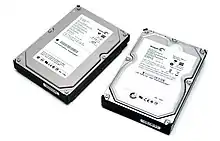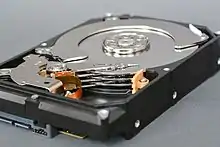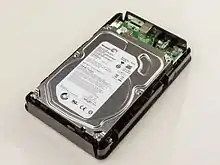Seagate Barracuda
The Seagate Barracuda is a series of hard disk drives produced by Seagate Technology. Most of the drives in this series have a spindle speed of 7200 RPM. The line initially focused on high-capacity, high-performance SCSI drives; since 2001, it became Seagate's most popular product as the hard disk drive industry started to move to a 7200 RPM spindle speed.

SCSI models
Launched in October 1992, the Seagate Barracuda 1 was the first 7200 RPM hard drive.[1] Owing to its rotational speed, it was very fast but very expensive at the time. Its Fast SCSI-2 interface targeted the drive to servers and high-performance systems. The original Barracuda offering, the ST11950N and ST11950ND, was in a 3.5 inch "half height" format that was popular at the time, giving it a height of 1.63 inches or 41.4 mm. It boasted a 5 year warranty, 500,000 hour MTBF, 4.17 msec latency, and a 10 Mbit/s transfer speed on the Fast SCSI-2 bus.[2] Bus speeds of the original Barracuda line would soon go up to 100 Mbit/s by 1995, even as capacity increased substantially in the first 4 iterations of the Barracuda.[2]
Later models, called the Barracuda 2LP series, began using the "low profile" common today by shrinking the height to 1 inch. These drives, the ST32550 and ST31250 with different suffixes for different bus configurations, were available starting in January 1994 with a 2.5 GB[3] or 1.2 GB capacity with three or six platters.[1][4]
ATA and SATA models
Barracuda ATA (1999)
Available in capacities between 6.8 GB and 28.2 GB, with a 512 KB[5] cache buffer and an ATA/66 interface. This is the first model in the Barracuda family equipped with an ATA/IDE interface.[6]
Barracuda ATA II (2000)
Available in capacities between 10 GB and 30 GB, with a 2 MB (2 MiB) cache. Supports up to ATA/66 interface.[7]
Barracuda ATA III (2000)
Available in capacities between 10 GB and 40 GB, with a 2 MB cache. Supports up to ATA/100 interface.[8]
Barracuda ATA IV (2001)
Available in capacities between 20 GB and 80 GB, with a 2 MB cache. Supports up to the ATA/100 interface. These drives operate very quietly as they are one of the first hard drives to use fluid dynamic bearings in their spindle motors.[9]
These disks cannot operate reliably at ATA/100 on RCC/ServerWorks IDE controllers, as their drivers blacklist the disks, thus limiting their operation to ATA/66.
Barracuda ATA V (2002)/Barracuda ATA V Plus (2003)/Barracuda Serial ATA V (2003)
Available in capacities between 30 GB to 120 GB, with a 2 MB cache, with either SATA/150 and ATA/100 interfaces. Barracuda V with SATA port is one of the first hard drives to feature a SATA interface.[10]
The SATA models have many problems, including random data loss (such as disappearing partitions). These disks cannot work with some Silicon Image SATA controllers, as their drivers blacklist the disks and limit the maximum sectors of each transaction below 8 KB (15 sectors), leading to considerably reduced performance.
Barracuda 7200.7 (2003)/Barracuda 7200.7 Plus (2004)
Available in capacities between 40 GB and 200 GB, with ATA/100 and SATA with NCQ. The drives have 2 MB or 8 MB of cache, depending on the model.[11]
Barracuda 7200.8 (2004)
Available in capacities between 200 GB and 400 GB, with either an ATA/100 or SATA interface with NCQ, these were sold alongside the 7200.7 series, providing higher capacities than the 7200.7. The drives have 8 MB or 16 MB of cache, depending on the model.[12]
Barracuda 7200.9 (2005)
Available in capacities between 40 GB and 500 GB, with either ATA/100 or SATA 3 Gbit/s interfaces. 2 MB, 8 MB or 16 MB, depending on the model and interface.
Barracuda 7200.10 (2006)
Available in capacities between 80 GB to 750 GB and either an ATA/100 or SATA 3 Gbit/s interface. 2, 8 or 16 MB of cache, depending on the model. This was the first Seagate hard drive to use perpendicular magnetic recording technology (only in 250 GB models: ST3250410AS with 16 MB of cache and ST3250310AS with 8 MB of cache).
This is the last generation of Barracuda to feature IDE interface on certain models. This is the only generation of Barracuda to feature 750 GB as the greatest in storage limit of IDE drive ever made by any manufacturer. Industry's competitors ended development of IDE hard drives on lower capacities: Maxtor (before its acquisition by Seagate) and Western Digital ended on 500 GB and Hitachi and Samsung ended on 400 GB.
Firmware bug
The SATA models of this family with firmware 3.AAK [codename GALAXY] or older (e.g. 3.AAE[codename TONKA]) have introduced a firmware (microcode) bug:
- There is a performance anomaly using hdparm with an NCQ queue depth of 31 in AHCI mode. Speed test measures only 55–64 MB/s (expected: >70–75 MB/s).[13]
Seagate does not officially provide firmware updates for this issue; however, an unofficial firmware update (3.AAM) exists for the following drive models:
- ST3320820AS with part number 9BJ13G-308,
- ST3320620AS with part number 9BJ14G-308 (with firmware 3.AAK),
- ST3500830AS with part number 9BJ136-308 and
- ST3500630AS with part number 9BJ146-308.
Barracuda ES (2006)
Available in capacities between 250 GB to 750 GB, with SATA 3 Gbit/s interface and 8 or 16 MB of cache depending on model. The ES (Enterprise Storage) family were high-reliability drives based on Barracuda 7200.10 design. Intended for business-critical use, with all drives having a 5-year warranty. Barracuda ES series replaced previous NL35 series (based on 7200.8) and NL35.2 series (based on 7200.9) enterprise drives.
Barracuda 7200.11 (2007)
With a SATA 3 Gbit/s interface, capacities range from 160 GB to 1.5 TB.[14] Codenames are Moose (earlier revision) and Brinks (later revision). Their cache size can be 8 MB, 16 MB or 32 MB, depending on the drive model.[15]
Firmware bug
This family has introduced many severe firmware (microcode) bugs:
- Disks may not show and utilize all the cache.[16]
- FLUSH_CACHE commands may time out when NCQ is used.[17]
- There is a performance anomaly using hdparm with NCQ queue depth 31 in AHCI mode. Speed test measures only 45–50 MB/s (expected: > 100–110 MB/s).
- Disks may be inaccessible at power on.[18][19]
Disks affected by the last bug will not be detected by the computer BIOS after a reboot. Numerous users have complained about this and are discussing it in a public forum[20] when discussions in Seagate's forums[21] were subjected to heavy moderation and subsequently closed. The symptom of the problem is that the computer BIOS will no longer detect the hard disk after a reboot, and upon connecting to the hard disk with a serial TTL board, this error code will be seen as "LED:000000CC FAddr:0024A051." Faulty firmware triggers this "failure."
Seagate FreeAgent external drives have also utilized 7200.11 hard disks with the SDxx firmware, and failures of these hard drives were also reported. The access LED remains permanently on, despite being disconnected from USB and no longer being recognized by the computer. However, Seagate says that the LED light remaining permanently on had nothing to do with firmware problems. The drives have also become known for their unusually high failure rates, including sudden mechanical failures; the rapid development of large numbers of bad sectors; the motherboard detecting the drive as a different model and the drive regularly "freezing" when being read from or written to.
Other companies have claimed to be able to resolve this problem using their own solution, namely Ace Laboratory PC3000-UDMA (version 4.13).
In order to fix the first bug, Seagate released firmware update AD14 for the affected disk models; to fix the second, third and fourth bugs, Seagate released firmware updates SD1A, SD1B, SD2B and SD81. The SD2B firmware update for Brinks removes the DCO ATA feature from the disks, while SD1A for Moose adds two ATA features.
Barracuda ES.2 (2007)
Available in capacities between 250 GB and 1 TB, 16 MB cache for SAS models and a 32 MB cache for SATA 3 Gbit/s models. Enterprise-grade drives based on 7200.11 series.[22]
Firmware bugs
Similar to the 7200.11 family, this family has introduced many firmware (microcode) bugs, which was fixed by SN06 firmware released by seagate:
- RAID arrays using these disks may fail.[23]
- Secure Erase command is not handled properly.[24]
- There is a performance anomaly using hdparm with NCQ queue depth 31 in AHCI mode. Speed test measures only 50 MB/s (expected: >100 MB/s).[17]
- Disks may be inaccessible at power on.[25]
Barracuda ES.2 is currently the last product in Seagate's enterprise line to bear the "Barracuda" name. The successor of ES.2, launched in early 2013,[26] is branded as "Constellation ES.3" which is based on the design of 14th-generation Barracuda.
Barracuda 7200.12 (2009)
Available in capacities between 160 GB to 1.0 TB. Initial models (CCxx firmware) supported up to SATA 3 Gbit/s, while later revisions (firmware JCxx) support the newer SATA 6 Gbit/s interface.[27] Their cache size can be 8 MB, 16 MB or 32 MB, depending on the drive model. Power consumption is reduced from previous models, resulting in lower heat dissipation and claimed reliability improvements.
Barracuda XT, LP and Green (13th generation) (2010)

Available in capacities between 2 TB and 3 TB (XT) with 64 MiB cache, 1 TB and 2 TB (LP) with 16 MiB or 32 MiB cache, 1 TB, 1.5 TB and 2 TB (Green) with 16 MiB to 64 MiB cache depending on model. This is the first Barracuda series to support SATA 6 Gbit/s and its buffer size is 64 MB. Rotation speed is 7,200 RPM for XT, and 5,900 RPM for LP and Green.
XT is Intended for high-performance gaming computers and workstations with sustained data transfer rate of 149 MB/s. LP is designated for mass storage applications favoring low heat output, quiet operation and better-than-average energy efficiency.

The Barracuda Green series was introduced in December 2010 as a high-performance, eco-friendly, low-power internal drive, replacing the Barracuda LP series.[28] It is the first to use Advanced Format sectors and operates at 5900 RPM.
Firmware bugs
The Barracuda LP series also present firmware issues that might be alleviated by the latest firmware available on the Seagate web site (CC35),[29] although there are reports that drives with the CC35 firmware loaded continue to exhibit the same problems as earlier firmware releases.[30] The most commonly referred issue with the Barracuda LP series drives appears to be one variation or another of the infamous click of death problem; the drive will start to emit a regular clicking noise at some point in its early life (possibly even at first start) and after some time will fail altogether, often after a few months of use. While the clicking noise is emitted, the hard drive is inaccessible and may prevent the BIOS from detecting it.
There is also a CC95 firmware (at least some of those drives came as part of external Seagate FreeAgent drives), but it is not clear whether this build fixes all known issues, and why firmware versions between CC35 and CC95 do not seem to exist.
Barracuda (14th generation) (2012)
Available in capacities between 250 GB to 3 TB, 7200 RPM, 16 MB to 64 MB cache, depending on the model. First Seagate hard drives with 1 TB[31] per platter technology. From this generation onwards, Seagate phased out previous "green" models, citing the inherent power saving functions featured on the 14th generation removed the need for a separate low-power design.
BarraCuda (16th generation) (2016)
The successor of the 14th generation Barracuda, branded as "Desktop HDD", was a 5,900 RPM series launched in early 2013 and was not considered part of the Barracuda line.
"Barracuda" series made a comeback in 2016 with a stylized BarraCuda trademark. Available in capacities between 500 GB to 8 TB. Buffer sizes vary from 32 MB (32 MiB) for 500 GB and 1 TB models to 256 MB (256 MiB) for 3 TB to 8 TB units.[32]
BarraCuda Pro (2016)
Available in capacities between 2 TB and 14 TB. Launched alongside BarraCuda, it is described as "Perfect for high performance desktop, creative pro desktop applications, and gaming".[32] This series has higher read/write performance than standard BarraCuda drives; one PCWorld review noted its consistent read speed throughout its entire capacity, which is unusual for a conventional HDD.[33]
Warranty length
Warranty period is either 1 year, 2 years, 3 years or 5 years from the documented date of purchase, depending on the type of product and where it was purchased.[34]
See also
References
- Seagate SEC filing, 1995
- barracuda 3.5 inch family, half-height
- 1 GB = 10003 bytes
- "Seagate Barracuda 2LP Manual" (PDF).
- 1 KB = 1024 B (1 KiB)
- "Seagate Barracuda ATA Manual" (PDF).
- "Seagate Barracuda ATA II Manual" (PDF).
- "Seagate Barracuda ATA III Manual" (PDF).
- "Seagate Barracuda ATA IV Manual" (PDF).
- "Seagate Barracuda ATA V Manual" (PDF).
- "Seagate Barracuda 7200.7/7200.7 Plus Manual" (PDF).
- "Seagate Barracuda 7200.8 Manual" (PDF).
- 1 MB = one million bytes
- 1 TB = one thousand billion bytes (1000 GB)
- http://www.seagate.com/docs/pdf/datasheet/disc/ds_barracuda_7200_11.pdf
- http://seagate.custkb.com/seagate/crm/selfservice/search.jsp?DocId=203791
- "Known issues - ata Wiki". ata.wiki.kernel.org.
- http://seagate.custkb.com/seagate/crm/selfservice/search.jsp?DocId=207951
- http://seagate.custkb.com/seagate/crm/selfservice/search.jsp?DocId=207957
- "Seagate Barracuda 7200.11 Troubles". MSFN.
- "Archived copy". Archived from the original on 2009-01-18. Retrieved 2009-01-09.CS1 maint: archived copy as title (link)
- http://www.seagate.com/files/docs/pdf/datasheet/disc/ds_barracuda_es.pdf
- "Known Issues with Seagate Barracuda ES.2 SATA 3 Gbit/s Disk Drives". ask.adaptec.com.
- "NETGEAR ReadyNAS • View topic - ReadyNAS Pro HDs, 1 TB Seagate ES.2 compat, Cisco switches". February 20, 2012. Archived from the original on February 20, 2012.
- "Firmware Update for ST3250310NS, ST3500320NS, ST3750330NS, ST31000340NS | Seagate Support". knowledge.seagate.com.
- "Seagate Enterprise Capacity 3.5 HDD Constellation ES.3 Review | StorageReview.com - Storage Reviews". www.storagereview.com. February 15, 2013.
- "(Page 28 of the Seagate Barracuda 7200.12 manual.)" (PDF). Archived from the original (PDF) on March 31, 2010.
- Domingo, By Joel Santo; December 14, 2010 3:08PM EST; December 14, 2010. "Seagate Introduces High Performance Green Drive". PCMAG.CS1 maint: numeric names: authors list (link)
- "Barracuda LP Firmware Update | Seagate Support". knowledge.seagate.com.
- http://forums.seagate.com/t5/Barracuda-XT-Barracuda-and/ST31000528AS-7200-12-1TB/m-p/43562
- 1 TB = one thousand billion bytes
- "BarraCuda and BarraCuda Pro Internal Hard Drives | Seagate US". Seagate.com.
- "Seagate Barracuda Pro 10TB hard drive review: Vast and amazingly fast (for a hard drive)". PCWorld. August 26, 2016.
- "Verify Warranty and Submit Return | Seagate Support US". Seagate.com.
